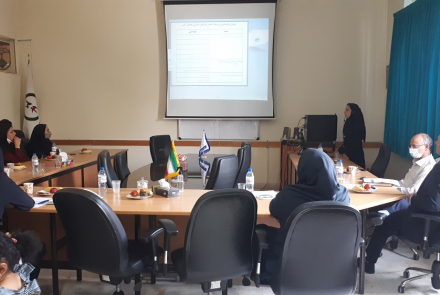دفاع پایان نامه دکتری آموزش بهداشت و ارتقاء سلامت خانم فاطمه صابر
دوشنبه 13 تیر ماه 1401 فاطمه صابر از پایان نامه خود با عنوان" نقشهنگاری مداخله با پیامهای آموزشی پیشگیری از رفتارهای مخاطرهآمیز منجر به آسیب، در دوچرخهسواران نوجوان پسر شهر اصفهان: یک مطالعه ترکیبی"به راهنمایی خانم دکتر فرشته زمانی علویجه و مشاوره اساتید خانم دکتر فیروزه مصطفوی، آقای دکترمهدی میرزایی علویجه و خانم دکتر زهرا حیدری دفاع نمودند.
چکیده
مقدمه و هدف: تصادفات ترافیکی جاده یکی از علتهای مهم آسیبها و تلفات در افراد جوان است و در این میان دوچرخهسواران یکی از آسیبپذیرترین کاربران جاده هستند. مطالعه حاضر به منظور توسعه برنامه آموزشی پیشگیری از رفتارهای مخاطرهآمیز منجر به آسیب مبتنی بر رویکرد نقشهنگاری مداخله در دوچرخهسواران نوجوان پسر شهر اصفهان انجام پذیرفت.
روش کار: در مطالعه حاضر از رویکرد نقشهنگاری مداخله به عنوان چارچوب برنامهریزی از مهرماه 1398 تا شهریورماه سال 1400، برای توسعه برنامه مطالعه دوچرخهسواری ایمن به روش ترکیبی از نوع متوالی اکتشافی استفاده شد. در این مطالعه شش گام نقشهنگاری مداخله تکمیل گردید. اساس نیازسنجی در گام اول مصاحبه فردی و بحث گروهی متمرکز با دوچرخهسواران نوجوان به روش تحلیل محتوای قراردادی بود. در گام دوم از تقاطع اهداف عملکردی و تعیینکنندههای مرتبط، ماتریکس اهداف تغییر شکل گرفت. در ادامه، پس از طراحی برنامه و برنامهریزی پیادهسازی مداخله، طرح ارزشیابی برنامه و توسعه و روانسنجی پرسشنامه انجام شد. پرسشنامه اولیه برای سنجش رفتارهای نمایشی و عوامل مرتبط با آن، بر اساس اطلاعات حاصله از مطالعه کیفی و مرور متون، تدوین شد. پس از ارزیابی و تأمین روایی صوری و محتوایی پرسشنامه، در یک مطالعه مقطعی، گامهای روانسنجی به منظور تأمین روایی سازه پرسشنامه از طریق فاکتور آنالیز انجام شد. پایایی درونی و بیرونی ابزار به ترتیب از طریق تخمین آلفای کرونباخ و test-retest با استفاده از ضریب همبستگی درون طبقهای (ICC) تعیین شد.
|
آ |
یافتهها: بر اساس یافتههای مطالعه کیفی در نیازسنجی یافته هایی به شرح ذیل استخراج شدند، انواع رفتارهای مخاطرهآمیز دوچرخهسواران در 2 دسته شامل: 1) انواع رفتارهای مخاطرهآمیز غیرعمدی؛ 2) انواع رفتارهای مخاطرهآمیز عمدی. عوامل روانشناختی مؤثر در شکلگیری رفتارهای نمایشی مخاطرهآمیز در 3 دسته شامل: 1) عوامل فردی مستعد کننده؛ 2) عوامل اجتماعی مساعدکننده؛ و 3) عوامل محیطی قادر کننده و نهایتاً عوامل مرتبط با رفتارهای مخاطرهآمیز غیرعمدی در 3 دسته شامل: 1) پایین بودن تمرکز؛ 2) دوچرخهسواری بدون داشتن مهارت و تجربه کافی؛ 3) شرایط نامساعد محیطی. با توجه به محدودیت منابع و زمان در این مطالعه انواع تعیینکنندههای مهم و قابل تغییر در سطح رفتاری شامل خطر درک شده، هیجان خواهی، برتری درک شده، باورهای هنجاری، قوانین ترافیکی و عادت، تنها برای رفتارهای نمایشی به عنوان یکی از رفتارهای مخاطرهآمیز مشخص و در ادامه ماتریکس اهداف تغییر رسم گردید. سپس روشها و استراتژیها متناسب با این تعیین کنندهها شناسایی و انتخاب گردیدند. در ادامه برنامه آموزشی به مدت 6 هفته مطابق با اهداف تغییر جهت اجرا در مدرسه برنامهریزی گردید، همچنین پیامهای آموزشی برنامه توسط گروهی از متخصصین و گروه هدف اعتبارسنجی و بر اساس نتایج حاصل از اعتبارسنجی در برخی از قسمتهای آن تغییراتی اعمال و پیامهای نهایی استخراج شد. سپس برنامهریزی در خصوص تضمین پذیرش، اجرا و حفظ برنامه با ساخت ماتریکس انتشار صورت گرفت. در نهایت دو ابزار رفتارهای نمایشی و عوامل مرتبط با آن رفتارها تدوین شد. روایی محتوا و سازه با تکنیک تحلیل عامل اکتشافی انجام و در نهایت پرسشنامه انواع رفتارهای نمایشی مخاطرهآمیز شامل 18 آیتم شد و 3 عامل از آن استخراج شد. بار عاملی آیتمها در دامنه36/ 0 الی 0/79 قرار داشت. بر اساس شاخص آلفا کرونباخ، پایایی درونی برای کل ابزار 0/914و بر اساس شاخص ICC، پایایی بیرونی برای کل پرسشنامه برابر با 0/965 بود. پرسشنامه عوامل مرتبط با رفتارهای نمایشی دوچرخهسواران شامل 35 آیتم شد و 5 عامل از آن استخراج شد. بار عاملی آیتمها در دامنه 0/79 الی 0/7- قرار داشت. بر اساس شاخص آلفا کرونباخ، پایایی درونی برای کل ابزار 0/902و بر اساس شاخص ICC، پایایی بیرونی برای کل پرسشنامه برابر با 893 /0 بود. به این ترتیب برنامه آموزشی پیشگیری دوچرخهسواری ایمن توسعه یافت.
نتیجهگیری: رویکرد نقشهنگاری مداخله، توسعه دقیق و سیستماتیک برنامه دوچرخهسواری ایمن را امکان پذیر کرد تا بتوانیم از رفتارهای نمایشی مخاطرهآمیز حین دوچرخهسواری پیشگیری کنیم. همچنین توصیف دقیق این برنامه میتواند موجب تسهیل تکرار برنامه در زمینههای دیگر شود. بنابراین با توجه به تهیه پروتکل آموزشی با استفاده از رویکرد نقشهنگاری مداخله و طراحی ابزار مناسب در زمینه رفتارهای نمایشی مخاطرهآمیز، طراحی و پیادهسازی مداخله آموزشی بهمنظور ارتقاء آگاهی و کاهش رفتارهای مخاطرهآمیز در دوچرخهسوار نوجوان پسر پیشنهاد میشود.
کلیدواژه: رفتارهای مخاطرهآمیز، رفتارهای نمایشی، تصادفهای ترافیکی، آسیبهای ترافیکی، دوچرخهسواران، نوجوانان، نقشهنگاری مداخله
Abstract
Background: Road traffic accidents are one of the major causes of injuries and casualties among young people, and cyclists are one of the most vulnerable road users. The present study was conducted to develop a prevention training program of risky behaviors leading to injury based on the intervention mapping (IM) approach in adolescent male cyclists in Isfahan.
Materials and Methods: The present study is a study protocol in which the intervention mapping approach was used as a planning framework from September 2019 to September 2021 to develop a safe cycling study program by mixed method of type sequential exploratory design. In this study, six steps of IM were completed. The basis of the needs assessment in the first step was individual interviews and focus group discussions with adolescent cyclists using conventional content analysis. In the second step, from the intersection of performance goals and related determinants, the change objectives matrix was transformed. Then, after designing the program and planning the implementation of the intervention, the program evaluation plan and tool development and psychometrics were performed. The initial questionnaire was developed to assess the risky stunt behaviors and related factors, based on the information obtained from the qualitative study and literature review. After evaluating and ensuring the face and content validity of the questionnaire, in a cross-sectional study, psychometric steps were performed to ensure the construct validity of the questionnaire through factor analysis. The internal and external reliability of the tools were obtained respectively by estimating Cronbach's alpha and test-retest via the Interclass correlation coefficient (ICC).
Results: Based on the findings of the qualitative study, the types of risky behaviors of cyclists in 2 categories were obtained in the following order: 1) Types of unintentional risky behaviors; 2) Types of intentional risky behaviors. Also, 3 categories of psychological factors affecting the formation of risky stunt behaviors were extracted in the following order: 1) individual predisposing factors; 2) contributing social factors; And 3) enabling environmental factors and finally 3 categories of factors related to unintentional risk behaviors were obtained in the following order: 1) low concentration; 2) cycling without sufficient skills and experience; 3) Unfavorable environmental conditions. Due to the limited resources and time in this study, the types of important and changeable determinants at the behavioral level were identified only for stunt behaviors as one of the risky behaviors and then the matrix of change objectives was drawn. Then methods and strategies were identified and selected in accordance with these determinants. Then, the educational program was planned for 6 weeks in accordance with the objectives of the change to be implemented in the school. Then, planning was done to ensure the acceptance, implementation and maintenance of the program by creating a release matrix. Finally, two tools of risky stunt behaviors and factors related to those behaviors were developed. Content and structure validity was performed by exploratory factor analysis technique and finally the questionnaire of all types of risky stunt behaviors included 18 items and 3 factors were extracted from it. The factor load of the items ranged from 0.36 to 0.79. According to Cronbach's alpha index, internal reliability for the whole instrument was 0.914 and according to ICC index, external reliability for the whole questionnaire was 0.965. The questionnaire of factors related to the stunt risky behaviors of cyclists included 35 items and 5 factors were extracted from it. The factor load of the items ranged from 0.79 to -0.7. According to Cronbach's alpha index, internal reliability for the whole instrument was 0.902 and according to ICC index, external reliability for the whole questionnaire was 0.893.
Conclusions: The intervention mapping approach enabled the careful and systematic development of a safe cycling program to prevent risky stunt behaviors while cycling. Also, a detailed description of the program can facilitate the repetition of the program in other areas. Therefore, considering the preparation of an educational protocol using the intervention mapping approach and designing appropriate tools in the field of risky behavioral behaviors, designing and implementing an educational intervention to raise awareness and reduce risky behaviors in adolescent male cyclists is recommended.
Keywords: Risky Behaviors, risky stunt, Traffic Accidents, Traffic Injuries, Cyclists, Adolescents, Intervention Mapping .




